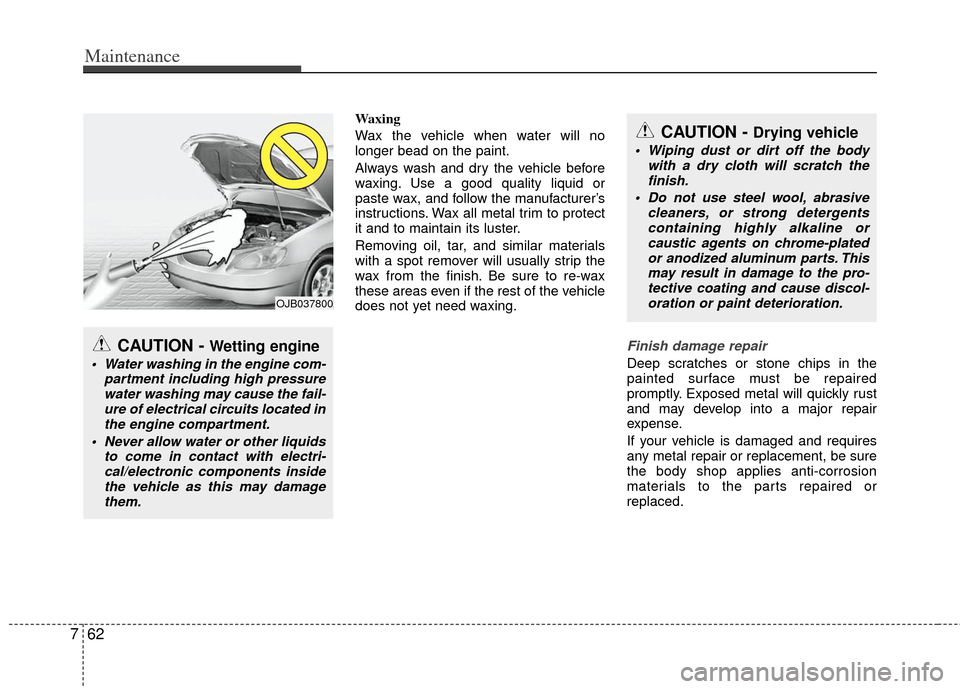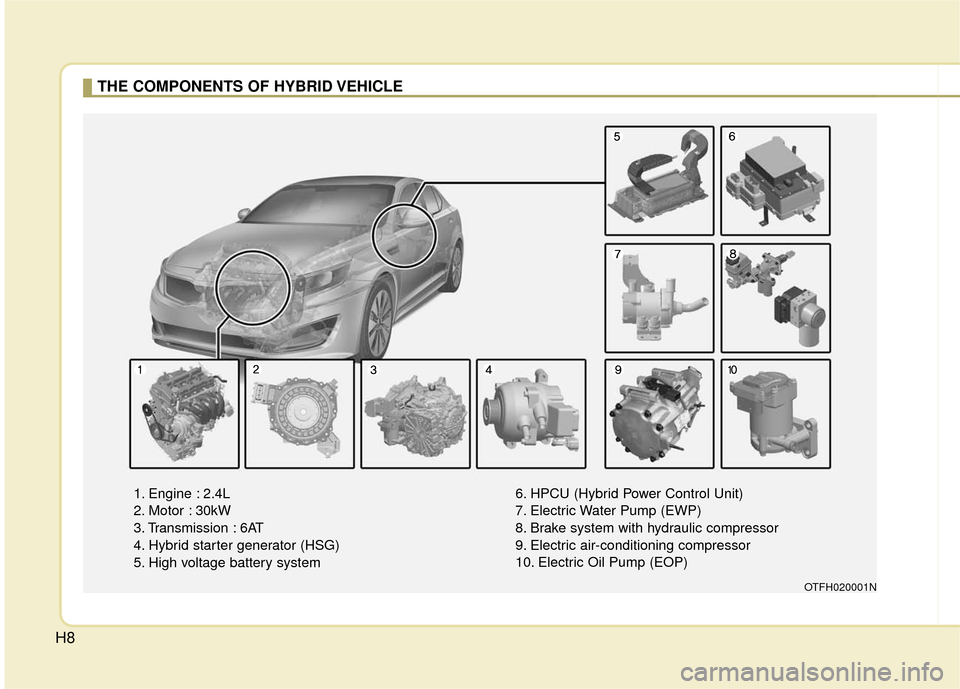2011 KIA Optima Hybrid engine oil
[x] Cancel search: engine oilPage 347 of 394

Maintenance
54
7
Multi fuse
If the multi fuse is blown, it must be
removed as follows:
1. Remove the fuse panel in the engine
compartment.
2. Remove the nuts shown in the picture above.
3. Replace the fuse with a new one of the same rating.
4. Reinstall in the reverse order of removal.
Oil pump cooling fuse/Cooling fan fuse
If the oil pump cooling fuse or cooling fan
fuse is blown, it must be removed as fol-
lows:
1. Turn off the engine.
2. Disconnect the negative battery cable.
3. Remove the fuse panel on the right side in the engine compartment.
4. Replace the fuse with a new one of the same rating.
5. Reinstall in the reverse order of removal.
Sub-relay fuse
If the sub-relay fuse is blown, it must be
removed as follows:
1. Turn off the engine.
2. Disconnect the negative battery cable.
3. Replace the fuse with a new one of thesame rating.
4. Reinstall in the reverse order of removal.
✽ ✽ NOTICE
If the multi or starting fuse is blown,
consult an authorized Kia dealer.
OVG079022OTFH070072NOYFH071021N
Page 351 of 394

Maintenance
58
7
Engine compartment main fuse panel
Description Fuse rating Protected component
MULTI FUSE IP B+ 2
60AI/P Junction Box (P/SEAT DRV 30A, P/SEAT PASS 20A, AMP 30A, PDM 2 7.5A, IPS 5,
IPS 6, ARISU 2)
AHB 1 60A Hydraulic Power Unit IGN 2 40A E/R Fuse & Relay Box (PDM 3 (IG 2) Relay)
ESC 1 40A ESC Module
RR HTD 40A E/R Fuse & Relay Box (RR HTD Relay)
BLOWER 40A E/R Fuse & Relay Box (Blower Relay)
IP B+ 1 60A I/P Junction Box (PDM 1 25A, MODULE 3 7.5A, S/HEATER FRT 20A, S/HEATER RR 15A,
TRUNK 10A, P/WDW LH 25A, P/WDW RH 25A), Power Connector (AUDIO 15A))
MDPS 80A EPS Control Module
FUSE WIPER 10A PCM
RR HTD IND 10A A/C Control Module OPCU 1 20A Electric Oil Pump Unit
INVERTER 10A MCU, Low Voltage DC-DC Converter, Active Air Flap TCU 1 20A PCM
STOP LP 15A Hybrid Fuse & Relay Box (HAC Relay), Smart Key Control Module, Stop Lamp Relay DEICER 20A E/R Fuse & Relay Box (Deicer Relay)
WATER PUMP 10A E/R Fuse & Relay Box (Water Pump Relay) BMS C/FAN 20A BMS Blower Motor Relay
IP B+ 3 50A I/P Junction Box (Power Connector (ROOM LP 10A), SUNROOF 20A, DR LOCK 20A, BMS 10A,
IPS 1, IPS 3, ARISU 1)
ESC 2 30A Multipurpose Check Connector, ESC Module HCU 20A Hybrid Control Unit
AHB 2 30A Hydraulic Power Unit
Page 355 of 394

Maintenance
62
7
Waxing
Wax the vehicle when water will no
longer bead on the paint.
Always wash and dry the vehicle before
waxing. Use a good quality liquid or
paste wax, and follow the manufacturer’s
instructions. Wax all metal trim to protect
it and to maintain its luster.
Removing oil, tar, and similar materials
with a spot remover will usually strip the
wax from the finish. Be sure to re-wax
these areas even if the rest of the vehicle
does not yet need waxing.
Finish damage repair
Deep scratches or stone chips in the
painted surface must be repaired
promptly. Exposed metal will quickly rust
and may develop into a major repair
expense.
If your vehicle is damaged and requires
any metal repair or replacement, be sure
the body shop applies anti-corrosion
materials to the parts repaired or
replaced.
CAUTION - Wetting engine
Water washing in the engine com-
partment including high pressurewater washing may cause the fail-ure of electrical circuits located in the engine compartment.
Never allow water or other liquids to come in contact with electri-cal/electronic components insidethe vehicle as this may damagethem.
OJB037800
CAUTION - Drying vehicle
Wiping dust or dirt off the body with a dry cloth will scratch thefinish.
Do not use steel wool, abrasive cleaners, or strong detergentscontaining highly alkaline orcaustic agents on chrome-plated or anodized aluminum parts. Thismay result in damage to the pro- tective coating and cause discol-oration or paint deterioration.
Page 365 of 394

Specifications, Consumer information, Reporting safety defects
28
CAPACITY/WEIGHT
Item
Displacement
Bore x Stroke
Firing order
No. of cylinders Gasoline (2.4)
2359 cc (143.96 cu.in)
88 x 97 mm (3.46 x 3.82 in.) 1-3-4-2
4, In-line
ENGINE BATTERY
Gross vehicle weight
kg (lbs.) Gasoline (2.4
)
2080 (4586)
280 (9.9)
Item
Luggage volume l(cu ft) A/T
Item
Battery pack voltage
Cell voltage
Cell and module
configuration
Battery system weight
Dimensions Hybrid
270V
3.75V
72 cells (9 modules x 8 cells per module)
42 kg (93 Ibs.) (system) 54.4L (211*355*726)
AIR CONDITIONING
Refrigerant type
Compressor oil R - 134a
PVE (Poly Vinyl Ether)
Components powered by the battery pack
- Electric motor, Power cable, HSG, Inverter/LDC, A/C Compressor
Page 368 of 394

5
Specifications, Consumer information, Reporting safety defects
RECOMMENDED LUBRICANTS AND CAPACITIES
To help achieve proper engine and powertrain performance and durability, use only lubricants of the proper quality. The correct
lubricants also help promote engine efficiency that results in improved fuel economy.
These lubricants and fluids are recommended for use in your vehicle.
*
1Refer to the recommended SAE viscosity numbers on the next page.
*2Engine oils labeled Energy Conserving Oil are now available. Along with other additional benefits, they contribute to fuel econ-
omy by reducing the amount of fuel necessary to overcome engine friction. Often, these improvements are difficult to measure
in everyday driving, but in a year’s time, they can offer significant cost and energy savings.
*
3If the API service SM engine oil is not available in your country, you are able to use API service SL.
LubricantVolumeClassification
Engine oil *1 *2
(drain and refill)
Recommended
(or equivalent)4.76 US qt. (4.5 l)API Service SM*3,
ILSAC GF-4 or above
Automatic transaxle fluid6.87 US qt. (6.5 l)MICHANG ATF SP-IV, SK ATF SP-IV
NOCA ATF SP-IV, KIA genuine ATF SP-IV
Coolant 6.97~7.29 US qt. (6.6~6.9 l)Mixture of antifreeze and water (Ethylene glycol base
coolant for aluminum radiator)
Inverter coolant2.39 US qt. (2.26 l)Mixture of antifreeze and water (Ethylene glycol basecoolant for aluminum radiator)
Brake fluid0.7~0.8 US qt.
(0.7~0.8 l)FMVSS116 DOT-3 or DOT-4
Fuel17.2 US gal. (65 l)Unleaded gasoline
8
Page 369 of 394

Specifications, Consumer information, Reporting safety defects
68
Recommended SAE viscosity
number Engine oil viscosity (thickness) has an
effect on fuel economy and cold weather
operating (engine start and engine oil
flowability). Lower viscosity engine oils
can provide better fuel economy and cold
weather performance, however, higher
viscosity engine oils are required for sat-
isfactory lubrication in hot weather. Using
oils of any viscosity other than those rec-
ommended could result in engine dam-
age.When choosing an oil, consider the
range of temperature your vehicle will be
operated in before the next oil change.
Proceed to select the recommended oil
viscosity from the chart.
CAUTION
Always be sure to clean the area
around any filler plug, drain plug, ordipstick before checking or drain-ing any lubricant. This is especiallyimportant in dusty or sandy areasand when the vehicle is used on unpaved roads. Cleaning the plugand dipstick areas will prevent dirtand grit from entering the engineand other mechanisms that couldbe damaged.
Temperature Range for SAE Viscosity Numbers
Temperature
Engine Oil *
1
°C
(°F)-30 -20 -10 0 10 20 30 40 50 -10 0 20 40 60 80 100 120
1. For better fuel economy, it is recommended to use theengine oil of a viscosity grade SAE 5W-20 (API Service SM
/ ILSAC GF-4). However, if the engine oil is not available,
select the proper engine oil using the engine oil viscosity
chart.
10W-30
5W-20, 5W-30
Page 379 of 394

H8
THE COMPONENTS OF HYBRID VEHICLE
1. Engine : 2.4L
2. Motor : 30kW
3. Transmission : 6AT
4. Hybrid starter generator (HSG)
5. High voltage battery system6. HPCU (Hybrid Power Control Unit)
7. Electric Water Pump (EWP)
8. Brake system with hydraulic compressor
9. Electric air-conditioning compressor
10. Electric Oil Pump (EOP)
OTFH020001N
Page 389 of 394

Index
4I
Driving in flooded areas ··················\
··················\
············5-35
Driving in the rain··················\
··················\
··················\
····5-35
Economical operation ··················\
··················\
················5-31
Electric chromic mirror (ECM) with HomeLink system ··················\
··················\
··················\
··················\
··4-37
Electric power steering ··················\
··················\
··············4-34
Electronic stability control (ESC) ··················\
···············5-20
Emergency starting ··················\
··················\
··················\
····6-5 Jump starting ··················\
··················\
··················\
···········6-5
Push starting ··················\
··················\
··················\
············6-6
Emergency while driving ··················\
··················\
·············6-3
Emission control system ··················\
··················\
············7-68 Crankcase emission control system··················\
···········7-68
Evaporative emission control System ··················\
·······7-68
Exhaust emission control system ··················\
··············7-69
Engine ··················\
··················\
··················\
··················\
······8-2
Engine compartment ··················\
··················\
············2-4, 7-2
Engine coolant ··················\
··················\
··················\
·········7-24
Engine number ··················\
··················\
··················\
···········8-8
Engine oil ··················\
··················\
··················\
·················7-22\
Engine overheats ··················\
··················\
··················\
········6-7
Engine start/stop button ··················\
··················\
···············5-5
Engine temperature gauge ··················\
··················\
·········4-50 Evaporative emission control System ··················\
··········7-68
Exhaust emission control system··················\
·················7-69\
Explanation of scheduled maintenance items ···············7-19
Exterior care··················\
··················\
··················\
·············7-61
Flat tire (with spare tire) ··················\
··················\
············6-13
Changing tires··················\
··················\
··················\
········6-14
Compact spare tire ··················\
··················\
··················\
·6-19
Jack and tools ··················\
··················\
··················\
········6-13
Removing and storing the spare tire···········\
·················6-14\
Flat tire (with tire mobility kit) ··················\
··················\
·6-21
Floor mat anchor(s) ··················\
··················\
·················4-11\
6
Fluid Brakes fluid ··················\
··················\
··················\
···········7-28
Washer fluid··················\
··················\
··················\
···········7-29
Front passenger and rear seat 3-point system with combination locking retractor ··················\
··················\
·3-19
Front seat adjustment ··················\
··················\
··················\
·3-4
Fuel filler lid ··················\
··················\
··················\
············4-25
Fuel gauge··················\
··················\
··················\
················4-49
Fuel requirements ··················\
··················\
··················\
······1-3
Fuse/relay panel description ··················\
··················\
······7-55
Fuses ··················\
··················\
··················\
··················\
······7-51 Fuse/relay panel description ··················\
··················\
····7-55
Instrument panel fuse ··················\
··················\
··············7-52
Memory fuse··················\
··················\
··················\
··········7-52
Multi fuse ··················\
··················\
··················\
··············7-54
E
F